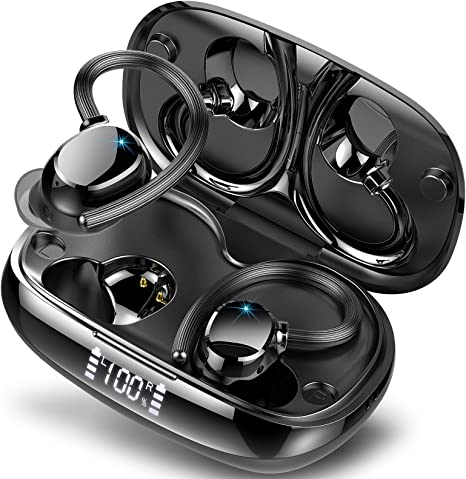A Smarter Way to Judge Audio Quality: A Context-Based Guide
Update on Oct. 15, 2025, 2:31 p.m.
In the product reviews for a pair of open-ear audio glasses, a curious comment stands out. A user, identifying himself as a “soundman for bands,” expresses that he is “extremely happy with the quality of the sound.” For anyone versed in the world of high-fidelity audio, this statement is a paradox. How could a professional, whose ears are trained to discern the subtlest nuances of sound, be satisfied with a device acoustically designed for compromise? This soundman’s surprising satisfaction isn’t a sign of compromised standards. It’s a sign of a paradigm shift in how we should think about audio quality—moving away from a single, absolute scale towards a smarter, context-based approach.

Beyond the Hi-Fi Myth: A Revolution in Context
For decades, the pursuit of “good audio” has been a monolithic quest for “high fidelity”—the perfect, uncolored reproduction of the original recording. This has been the gold standard, judged in silent rooms on a scale of absolute perfection. But this approach is fundamentally flawed because we don’t live our lives in soundproof listening rooms. We listen on noisy subways, in busy offices, and on windy jogging paths. It’s time to introduce a more relevant metric: the “Context Score.” The best audio device isn’t the one with the highest fidelity in a vacuum, but the one that scores highest in the context of your actual life.
Deconstructing Sound: The Four Pillars of Audio Quality
To apply a Context Score, we first need to break down the vague term “good sound” into more tangible components. Most listening experiences can be judged on four key pillars:
- Clarity: Can you easily distinguish between the singer’s voice, the guitar riff, and the bass line? Clarity is about the definition and separation of instruments and vocals.
- Impact: This is the physical sensation of sound, primarily the punch and texture of the bass. Does the kick drum thump in your chest, or does it just sound like a dull tap?
- Spaciousness (Soundstage): Does the music sound like it’s happening inside your head, or does it feel like you’re in a room with the musicians? A wide soundstage gives a sense of openness and dimension.
- Isolation / Immersion: How well does the device block out the outside world and draw you into the audio? This is the core of an immersive listening experience.
The Laws of Physics: Design Dictates Trade-offs
No single audio device can maximize all four pillars at once, because of the inescapable laws of physics. The design of a device represents a series of trade-offs.
- Traditional Over-Ear/In-Ear Headphones: These devices create a seal around or inside your ear. This seal is crucial for Isolation and is the primary reason they can produce powerful Impact (deep bass), as they create a small, pressurized air volume. They are built for immersion.
- Open-Ear Audio Devices (like Audio Glasses): By definition, these devices have no seal. They intentionally sacrifice Isolation to maximize situational awareness. This lack of a seal and their small driver size mean they must compromise on raw Impact. Their strength lies in providing a baseline of Clarity and a unique, open-air Spaciousness that feels more like ambient sound than a private concert.
This is a conscious design choice, a trade-off triangle between Immersion, Awareness, and Comfort. Open-ear audio, like that in the RERBO J6-8, chooses to excel at Awareness and Comfort, accepting a different audio presentation as a result.

Matching the Scorecard to Your Life
Understanding these trade-offs is empowering. It means we can stop asking “Which headphone is best?” and start asking the right question: “Which headphone is best for me, right now?”
- Scenario A: Critical Listening (Your Living Room): Your goal is pure immersion and fidelity. Context Score Priority: Clarity, Impact, Spaciousness. You need high Isolation. The clear winner here is a high-quality pair of closed-back or open-back over-ear headphones.
- Scenario B: The Noisy Commute (Subway/Bus): Your goal is to hear your audio above the roar. Context Score Priority: Isolation. Nothing else matters if you can’t hear the content. The champion is a pair of active noise-cancelling (ANC) headphones or snug-fitting in-ear monitors.
- Scenario C: Outdoor Run / Office Awareness: Your goal is safety and staying connected to your surroundings. Context Score Priority: Low Isolation (i.e., high awareness). Clarity just needs to be “good enough” for podcasts or background music. Here, an open-ear device scores perfectly, while a traditional headphone would be a dangerous, low-scoring choice.
This brings us back to our soundman. He likely has a world-class studio for critical listening (Scenario A). But for walking his dog or tinkering in his workshop (Scenario C), the audio glasses provide a perfectly clear and pleasant soundtrack without disconnecting him from his environment. In that context, they achieve a perfect score.
Don’t Forget the Other Side: Microphone Quality
In our world of endless calls and voice commands, audio quality is a two-way street. A device with a high-quality microphone array that cancels out background noise and makes your voice sound clear to others can be far more valuable in a work context than one with perfect music reproduction but a muffled mic.
So, the next time you read a review praising a device’s “crystal-clear highs” or “thumping bass,” take a moment to ask yourself: where will I be listening? The search for good audio is not a hunt for a single, mythical beast of perfect fidelity. It is a personal journey to find the right tool for the right job. The best sound system in the world is not the most expensive one, but the one that seamlessly and intelligently integrates with the unique, unrepeatable soundtrack of your life.






















